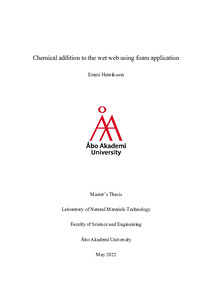Chemical addition to the wet web using foam application
Henriksson, Emmi (2022)
Henriksson, Emmi
2022
Julkaisu on tekijänoikeussäännösten alainen. Teosta voi lukea ja tulostaa henkilökohtaista käyttöä varten. Käyttö kaupallisiin tarkoituksiin on kielletty.
Julkaisun pysyvä osoite on
https://urn.fi/URN:NBN:fi-fe2022051736325
https://urn.fi/URN:NBN:fi-fe2022051736325
Tiivistelmä
Foam application is a promising new method for applying papermaking chemicals to wet paper webs. It is based on using aqueous foam as a carrier fluid and has simultaneously improved wet web runnability and furnish strength in previous studies. In this thesis a dynamical foam application device for applying a foam curtain to wet sheets on a moving wire is presented. It consists of a foam generator, a static slot-die coater and vacuum box, a wire fixed to a moving sled and a pressure transducer for vacuum monitoring. Chemical penetration was studied with cationic starch, foamed using a commercially available surfactant. The effects of substrate type, concentration of starch, amount of starch, viscosity of the starting liquid, vacuum, and drying method on starch penetration depth and dewatering properties were analyzed in three substrates: two types of bleached CTMP handsheets and pilot sheets made from kraft pulp. The mean relative starch penetration depths (MR-SPD) were calculated from iodine-stained cross-sections using image analysis software. Quantitative analyses were performed to measure total starch amount and z-directional distribution.
Operation of the foam application device was successful and target starch amounts were mostly reached in the range 1–5 g/m^2. The cross-section analysis correlated with results from z-directional distributions and samples had a MR-SPD 30–55%. The starch penetration depth in bulky CTMP handsheets could be controlled by changing the starting solution viscosity and amount of starch applied. Likely due to the different structure of pressed and re-wetted pilot sheets, no clear differences were detected and all MR-SPDs remained the same (ca. 50%). Vacuum suction and drying method had no apparent effect on penetration depth, but sheet dewatering efficiency improved in proportion to vacuum intensity. Overall, the results encourage further experimentation with different application parameters.
Operation of the foam application device was successful and target starch amounts were mostly reached in the range 1–5 g/m^2. The cross-section analysis correlated with results from z-directional distributions and samples had a MR-SPD 30–55%. The starch penetration depth in bulky CTMP handsheets could be controlled by changing the starting solution viscosity and amount of starch applied. Likely due to the different structure of pressed and re-wetted pilot sheets, no clear differences were detected and all MR-SPDs remained the same (ca. 50%). Vacuum suction and drying method had no apparent effect on penetration depth, but sheet dewatering efficiency improved in proportion to vacuum intensity. Overall, the results encourage further experimentation with different application parameters.
